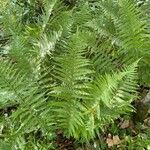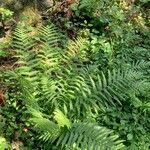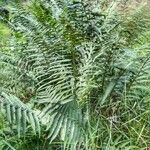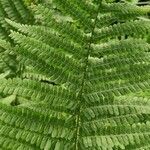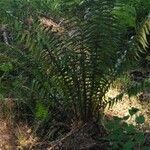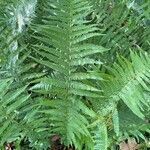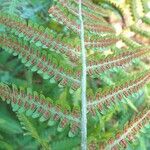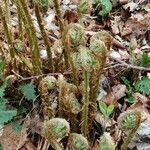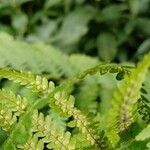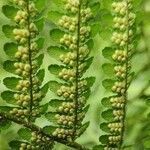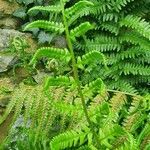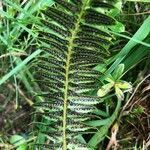Rhizome ascending or erect; lvs mostly deciduous, appearing more delicate and finely divided than in spp. 5 and 6; petiole a third as long as the blade, its numerous scales pale, concolored, the broad, toothed ones intermingled with narrow, hair-like ones; blade to 10+ dm, mostly 1.5–3 dm wide; pinnate-pinnatifid with numerous (mostly 20–30 pairs) of pinnae to 15 × 4 cm, the largest pinnae near or a little below the middle and with (15)20+ pairs of segments, many of the segments evidently contracted at the base; larger ultimate segments (0.7–)1–1.5(–2) cm; ramentum ± plentiful on the rachis and costae, sometimes on the lower surface of the blade, chiefly of narrow, elongate, hair-like scales, that of the rachis sometimes partly of more evident (but still narrow) scales; 2n=164. Thickets, moist woods, and streambanks; circumboreal, extending s. to Vt., n. Mich., ne. Ill., S.D., and Mex.
Rhizomes stout, erect, often covered in dead stipe bases. Stipes 10-40 cm long, pale brown. Stipes and rachises sparsely covered with pale brown scales. Laminae elliptic or narrowly elliptic, 2-pinnate, 30-125 × 15-30 cm, dark green above, paler below. Primary pinnae in 25-50 (or more) pairs, narrowly triangular or ± oblong, tapering at apices, sessile, 8-15 × 2-3 cm. Secondary pinnae in 15-30 pairs, oblong, adnate or decurrent on pinna midrib, rounded at apices, serrate all round, to 15 × 7 mm, the secondary pinnae on the basal pair of primary pinnae ± equal in length either side of midrib. Sori round, 1-5 pairs on each secondary pinna, often confined to upper pinnae, covered by flat reniform indusia.
Leaves monomorphic, dying back in winter, 28--120 × 10--30 cm. Petiole less than 1/4 length of leaf, scaly at least at base; scales scattered, brown, of 2 distinct kinds, 1 broad, 1 hairlike (only this species has 2 distinct forms of scales without intermediates). Blade green, ovate-lanceolate, pinnate-pinnatifid to 2-pinnate at base, firm but not leathery, not glandular. Pinnae ± in plane of blade, lanceolate; basal pinnae ovate-lanceolate, much reduced, basal pinnules or segments ± same length as adjacent pinnules, basal basiscopic pinnule and basal acroscopic pinnule equal; pinnule margins serrate to lobed. Sori midway between midvein and margin of segments. Indusia lacking glands. 2 n = 164.
A large fern. It grows 60-120 cm high and wide. The fronds are spear-shaped and deep glossy green. They are finely divided and they arch so that the tips almost touch the ground. It forms spores prolifically. There are some named cultivated varieties.
